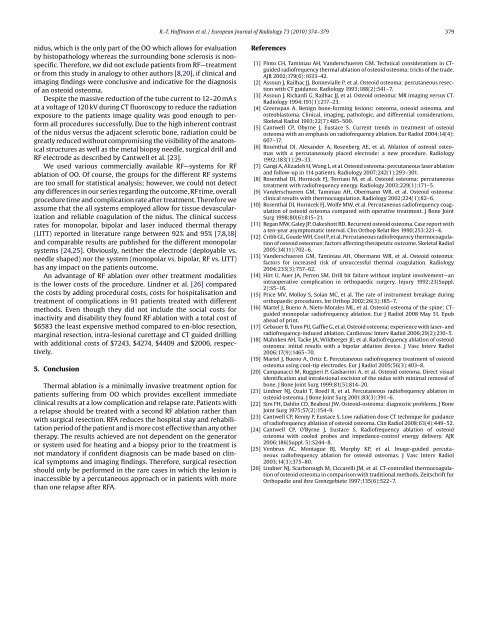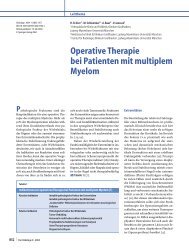European Journal of Radiology Radiofrequency ablation in the ...
European Journal of Radiology Radiofrequency ablation in the ...
European Journal of Radiology Radiofrequency ablation in the ...
You also want an ePaper? Increase the reach of your titles
YUMPU automatically turns print PDFs into web optimized ePapers that Google loves.
R.-T. H<strong>of</strong>fmann et al. / <strong>European</strong> <strong>Journal</strong> <strong>of</strong> <strong>Radiology</strong> 73 (2010) 374–379 379nidus, which is <strong>the</strong> only part <strong>of</strong> <strong>the</strong> OO which allows for evaluationby histopathology whereas <strong>the</strong> surround<strong>in</strong>g bone sclerosis is nonspecific.Therefore, we did not exclude patients from RF—treatmentor from this study <strong>in</strong> analogy to o<strong>the</strong>r authors [8,20], if cl<strong>in</strong>ical andimag<strong>in</strong>g f<strong>in</strong>d<strong>in</strong>gs were conclusive and <strong>in</strong>dicative for <strong>the</strong> diagnosis<strong>of</strong> an osteoid osteoma.Despite <strong>the</strong> massive reduction <strong>of</strong> <strong>the</strong> tube current to 12–20 mA sat a voltage <strong>of</strong> 120 kV dur<strong>in</strong>g CT fluoroscopy to reduce <strong>the</strong> radiationexposure to <strong>the</strong> patients image quality was good enough to performall procedures successfully. Due to <strong>the</strong> high <strong>in</strong>herent contrast<strong>of</strong> <strong>the</strong> nidus versus <strong>the</strong> adjacent sclerotic bone, radiation could begreatly reduced without compromis<strong>in</strong>g <strong>the</strong> visibility <strong>of</strong> <strong>the</strong> anatomicalstructures as well as <strong>the</strong> metal biopsy needle, surgical drill andRF electrode as described by Cantwell et al. [23].We used various commercially available RF—systems for RF<strong>ablation</strong> <strong>of</strong> OO. Of course, <strong>the</strong> groups for <strong>the</strong> different RF systemsare too small for statistical analysis; however, we could not detectany differences <strong>in</strong> our series regard<strong>in</strong>g <strong>the</strong> outcome, RF time, overallprocedure time and complication rate after treatment. Therefore weassume that <strong>the</strong> all systems employed allow for tissue devascularizationand reliable coagulation <strong>of</strong> <strong>the</strong> nidus. The cl<strong>in</strong>ical successrates for monopolar, bipolar and laser <strong>in</strong>duced <strong>the</strong>rmal <strong>the</strong>rapy(LITT) reported <strong>in</strong> literature range between 92% and 95% [7,8,18]and comparable results are published for <strong>the</strong> different monopolarsystems [24,25]. Obviously, nei<strong>the</strong>r <strong>the</strong> electrode (deployable vs.needle shaped) nor <strong>the</strong> system (monopolar vs. bipolar, RF vs. LITT)has any impact on <strong>the</strong> patients outcome.An advantage <strong>of</strong> RF <strong>ablation</strong> over o<strong>the</strong>r treatment modalitiesis <strong>the</strong> lower costs <strong>of</strong> <strong>the</strong> procedure. L<strong>in</strong>dner et al. [26] compared<strong>the</strong> costs by add<strong>in</strong>g procedural costs, costs for hospitalisation andtreatment <strong>of</strong> complications <strong>in</strong> 91 patients treated with differentmethods. Even though <strong>the</strong>y did not <strong>in</strong>clude <strong>the</strong> social costs for<strong>in</strong>activity and disability <strong>the</strong>y found RF <strong>ablation</strong> with a total cost <strong>of</strong>$6583 <strong>the</strong> least expensive method compared to en-bloc resection,marg<strong>in</strong>al resection, <strong>in</strong>tra-lesional curettage and CT guided drill<strong>in</strong>gwith additional costs <strong>of</strong> $7243, $4274, $4409 and $2006, respectively.5. ConclusionThermal <strong>ablation</strong> is a m<strong>in</strong>imally <strong>in</strong>vasive treatment option forpatients suffer<strong>in</strong>g from OO which provides excellent immediatecl<strong>in</strong>ical results at a low complication and relapse rate. Patients witha relapse should be treated with a second RF <strong>ablation</strong> ra<strong>the</strong>r thanwith surgical resection. RFA reduces <strong>the</strong> hospital stay and rehabilitationperiod <strong>of</strong> <strong>the</strong> patient and is more cost effective than any o<strong>the</strong>r<strong>the</strong>rapy. The results achieved are not dependent on <strong>the</strong> generatoror system used for heat<strong>in</strong>g and a biopsy prior to <strong>the</strong> treatment isnot mandatory if confident diagnosis can be made based on cl<strong>in</strong>icalsymptoms and imag<strong>in</strong>g f<strong>in</strong>d<strong>in</strong>gs. Therefore, surgical resectionshould only be performed <strong>in</strong> <strong>the</strong> rare cases <strong>in</strong> which <strong>the</strong> lesion is<strong>in</strong>accessible by a percutaneous approach or <strong>in</strong> patients with morethan one relapse after RFA.References[1] P<strong>in</strong>to CH, Tam<strong>in</strong>iau AH, Vanderschueren GM. Technical considerations <strong>in</strong> CTguidedradi<strong>of</strong>requency <strong>the</strong>rmal <strong>ablation</strong> <strong>of</strong> osteoid osteoma: tricks <strong>of</strong> <strong>the</strong> trade.AJR 2002;179(6):1633–42.[2] Assoun J, Railhac JJ, Bonnevialle P, et al. Osteoid osteoma: percutaneous resectionwith CT guidance. <strong>Radiology</strong> 1993;188(2):541–7.[3] Assoun J, Richardi G, Railhac JJ, et al. Osteoid osteoma: MR imag<strong>in</strong>g versus CT.<strong>Radiology</strong> 1994;191(1):217–23.[4] Greenspan A. Benign bone-form<strong>in</strong>g lesions: osteoma, osteoid osteoma, andosteoblastoma. Cl<strong>in</strong>ical, imag<strong>in</strong>g, pathologic, and differential considerations.Skeletal Radiol 1993;22(7):485–500.[5] Cantwell CP, Obyrne J, Eustace S. Current trends <strong>in</strong> treatment <strong>of</strong> osteoidosteoma with an emphasis on radi<strong>of</strong>requency <strong>ablation</strong>. Eur Radiol 2004;14(4):607–17.[6] Rosenthal DI, Alexander A, Rosenberg AE, et al. Ablation <strong>of</strong> osteoid osteomaswith a percutaneously placed electrode: a new procedure. <strong>Radiology</strong>1992;183(1):29–33.[7] Gangi A, Alizadeh H, Wong L, et al. Osteoid osteoma: percutaneous laser <strong>ablation</strong>and follow-up <strong>in</strong> 114 patients. <strong>Radiology</strong> 2007;242(1):293–301.[8] Rosenthal DI, Hornicek FJ, Torriani M, et al. Osteoid osteoma: percutaneoustreatment with radi<strong>of</strong>requency energy. <strong>Radiology</strong> 2003;229(1):171–5.[9] Vanderschueren GM, Tam<strong>in</strong>iau AH, Obermann WR, et al. Osteoid osteoma:cl<strong>in</strong>ical results with <strong>the</strong>rmocoagulation. <strong>Radiology</strong> 2002;224(1):82–6.[10] Rosenthal DI, Hornicek FJ, Wolfe MW, et al. Percutaneous radi<strong>of</strong>requency coagulation<strong>of</strong> osteoid osteoma compared with operative treatment. J Bone Jo<strong>in</strong>tSurg 1998;80(6):815–21.[11] Regan MW, Galey JP, Oakeshott RD. Recurrent osteoid osteoma. Case report witha ten-year asymptomatic <strong>in</strong>terval. Cl<strong>in</strong> Orthop Relat Res 1990;253:221–4.[12] Cribb GL, Goude WH, Cool P, et al. Percutaneous radi<strong>of</strong>requency <strong>the</strong>rmocoagulation<strong>of</strong> osteoid osteomas: factors affect<strong>in</strong>g <strong>the</strong>rapeutic outcome. Skeletal Radiol2005;34(11):702–6.[13] Vanderschueren GM, Tam<strong>in</strong>iau AH, Obermann WR, et al. Osteoid osteoma:factors for <strong>in</strong>creased risk <strong>of</strong> unsuccessful <strong>the</strong>rmal coagulation. <strong>Radiology</strong>2004;233(3):757–62.[14] Hirt U, Auer JA, Perren SM. Drill bit failure without implant <strong>in</strong>volvement—an<strong>in</strong>traoperative complication <strong>in</strong> orthopaedic surgery. Injury 1992;23(Suppl.2):S5–16.[15] Price MV, Molloy S, Solan MC, et al. The rate <strong>of</strong> <strong>in</strong>strument breakage dur<strong>in</strong>gorthopaedic procedures. Int Orthop 2002;26(3):185–7.[16] Martel J, Bueno A, Nieto-Morales ML, et al. Osteoid osteoma <strong>of</strong> <strong>the</strong> sp<strong>in</strong>e: CTguidedmonopolar radi<strong>of</strong>requency <strong>ablation</strong>. Eur J Radiol 2008 May 31, Epubahead <strong>of</strong> pr<strong>in</strong>t.[17] Gebauer B, Tunn PU, Gaffke G, et al. Osteoid osteoma: experience with laser- andradi<strong>of</strong>requency-<strong>in</strong>duced <strong>ablation</strong>. Cardiovasc Interv Radiol 2006;29(2):210–5.[18] Mahnken AH, Tacke JA, Wildberger JE, et al. Radi<strong>of</strong>requency <strong>ablation</strong> <strong>of</strong> osteoidosteoma: <strong>in</strong>itial results with a bipolar <strong>ablation</strong> device. J Vasc Interv Radiol2006;17(9):1465–70.[19] Martel J, Bueno A, Ortiz E. Percutaneous radi<strong>of</strong>requency treatment <strong>of</strong> osteoidosteoma us<strong>in</strong>g cool-tip electrodes. Eur J Radiol 2005;56(3):403–8.[20] Campanacci M, Ruggieri P, Gasbarr<strong>in</strong>i A, et al. Osteoid osteoma. Direct visualidentification and <strong>in</strong>tralesional excision <strong>of</strong> <strong>the</strong> nidus with m<strong>in</strong>imal removal <strong>of</strong>bone. J Bone Jo<strong>in</strong>t Surg 1999;81(5):814–20.[21] L<strong>in</strong>dner NJ, Ozaki T, Roedl R, et al. Percutaneous radi<strong>of</strong>requency <strong>ablation</strong> <strong>in</strong>osteoid osteoma. J Bone Jo<strong>in</strong>t Surg 2001;83(3):391–6.[22] Sim FH, Dahl<strong>in</strong> CD, Beabout JW. Osteoid-osteoma: diagnostic problems. J BoneJo<strong>in</strong>t Surg 1975;57(2):154–9.[23] Cantwell CP, Kenny P, Eustace S. Low radiation dose CT technique for guidance<strong>of</strong> radi<strong>of</strong>requency <strong>ablation</strong> <strong>of</strong> osteoid osteoma. Cl<strong>in</strong> Radiol 2008;63(4):449–52.[24] Cantwell CP, O’Byrne J, Eustace S. Radi<strong>of</strong>requency <strong>ablation</strong> <strong>of</strong> osteoidosteoma with cooled probes and impedance-control energy delivery. AJR2006;186(Suppl. 5):S244–8.[25] Venbrux AC, Montague BJ, Murphy KP, et al. Image-guided percutaneousradi<strong>of</strong>requency <strong>ablation</strong> for osteoid osteomas. J Vasc Interv Radiol2003;14(3):375–80.[26] L<strong>in</strong>dner NJ, Scarborough M, Ciccarelli JM, et al. CT-controlled <strong>the</strong>rmocoagulation<strong>of</strong> osteoid osteoma <strong>in</strong> comparison with traditional methods. Zeitschrift furOrthopadie und ihre Grenzgebiete 1997;135(6):522–7.





